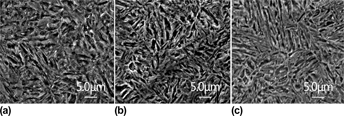Article contents
Effect of quenching and partitioning process to low-alloy wear resistant steel
Published online by Cambridge University Press: 11 March 2016
Abstract

To find the optimal Quenching and Partitioning (Q&P) process parameters of low-alloy wear resistant steel, various Q&P processes including quenching temperature, partitioning temperature and partitioning time were designed and tested by using orthogonal experiment method. Through analysis of orthogonal experiment, quenching temperature was the most important influential factor on the impact toughness and hardness, and partitioning time played a critical role on tensile strength. The optimal Q&P heat treatment parameters of low alloy wear resistant steel were partitioning at 350 °C for 10 min immediately after quenching at 100 °C. The microstructure of samples was composed of martensite laths and retained austenite. The relative volume fraction of retained austenite increased with the increase of quenching temperature and decreased gradually with the lengthening of partitioning time. Combining the results of Energy dispersive spectrometer, the reason for decrease of retained austenite was the existence of carbide precipitation and the carbide was (Fe, Cr)3C7. Compared to the traditional heat treatment of quenching and low temperature tempering, the samples under Q&P treatment displayed higher toughness and maintained relatively high tensile strength and wear resistance.
- Type
- Articles
- Information
- Copyright
- Copyright © Materials Research Society 2016
References
REFERENCES
- 5
- Cited by


